


xxxxxIt was in 1879 that an amateur
archaeologist named Marcelino de Sautuola discovered some
remarkable prehistoric wall paintings in a cave at Altamira in
northern Spain. He obtained the assistance of Juan Vilanova y
Piera, an archaeologist at Madrid University, and he confirmed
that they were stone-age images. They published their
findings, complete with accurate drawings, in 1880, but because
the paintings were so well preserved and the artistic quality was
so good, they were rejected by the specialists of the day. It was
not, in fact, until 1902, fourteen years after Sautuola ‘s death,
that they were accepted as genuine. The cave paintings date from
around 13,000 B.C., and the most spectacular cover the ceiling of
a side cavern, now known as the “Sistine Chapel of Paleolithic
Art”. Depicting a herd of bison, plus two horses and a wild boar,
these paintings are remarkable for their vibrant colour -
red, black and ochre - and the skill by which the artists
have created depth and movement by varying the tone of the dyes
and using to good effect the contours of the rock face. Some
paintings are simpler in style, and the many drawings and etchings
include a variety of handprints and some abstract symbols. Some of
the deeper chambers contain a large number of engraved and black-painted
figures. The purpose of this art work is unknown, but it probably
formed part of a hunting ceremony.
THE CAVE OF ALTAMIRA 1879 (Vb)
Acknowledgement
Sautuola: date and
artist unknown.
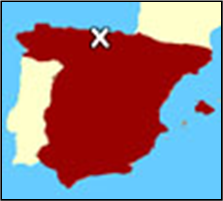 xxxxxIt was in 1868
that a local hunter named Modesto Peres stumbled
by chance upon a large cave situated on the hill of Altamira near
Santillana del Mar, close to the north coast of Spain. Herdsmen
and other hunters had often used the cave for shelter, but it was
he who noticed some outlined tracings on the walls near the
entrance and told others of his find. However, it was not until
1875 that the nobleman Don Marcelino de Sautuola (1831-1888), the owner of the area around the
cave and, as it so happened, an amateur archaeologist, began
visiting the cave complex. In addition to some black wall
paintings, he discovered a quantity of archaeological remains,
including a variety of flint implements, a large number of animal
bones (some engraved), and what appeared to be ceremonial staves.
But it was not until one day in the summer of 1879
when he was accompanied by his five-year old daughter Maria,
that the “polychrome ceiling” was revealed. Having wandered a
little further into the cave, she drew her father’s attention to
the colourful pictures of “bulls” (bison in fact) which covered
the roof of an adjoining cavern. The “Sistine Chapel of
Paleolithic Art” had at last been discovered.
xxxxxIt was in 1868
that a local hunter named Modesto Peres stumbled
by chance upon a large cave situated on the hill of Altamira near
Santillana del Mar, close to the north coast of Spain. Herdsmen
and other hunters had often used the cave for shelter, but it was
he who noticed some outlined tracings on the walls near the
entrance and told others of his find. However, it was not until
1875 that the nobleman Don Marcelino de Sautuola (1831-1888), the owner of the area around the
cave and, as it so happened, an amateur archaeologist, began
visiting the cave complex. In addition to some black wall
paintings, he discovered a quantity of archaeological remains,
including a variety of flint implements, a large number of animal
bones (some engraved), and what appeared to be ceremonial staves.
But it was not until one day in the summer of 1879
when he was accompanied by his five-year old daughter Maria,
that the “polychrome ceiling” was revealed. Having wandered a
little further into the cave, she drew her father’s attention to
the colourful pictures of “bulls” (bison in fact) which covered
the roof of an adjoining cavern. The “Sistine Chapel of
Paleolithic Art” had at last been discovered.
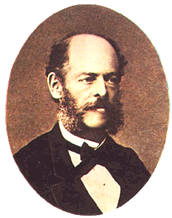 xxxxxHaving attended the World Exposition in Paris the
previous year, where he had seen similar images engraved on stone-age
objects, Sautuola (here
illustrated) then sought the advice of
Professor Juan Vilanova y Piera, an archaeologist at the University
of Madrid. After a careful study of the drawings, Piera became
convinced that they were genuine cave paintings of the Old Stone
Age. Together they compiled a book of their findings, complete with
accurate drawings of the paintings, and this was published in 1880
under the title Brief notes about some
prehistoric objects of the Santander province. It attracted
a deal of interest, but it was not taken seriously. Due to the
remarkable artistic quality of the paintings and the excellent state
of their preservation, the scientific world was in no way convinced.
A number of Spanish and foreign specialists, including the eminent
French anthropologist Gabriel de Mortillet, regarded the images as
fakes, and the leading French prehistorian Émile Cartailhac even
spoke of forgery. As a result their findings were rejected and
publicly ridiculed at the Prehistorical Congress held at Lisbon
later that year. It was not, in fact, until 1902 that, having been
able to compare the findings at Altamira with the discovery of other
prehistoric art work, the wall paintings were accepted as authentic.
xxxxxHaving attended the World Exposition in Paris the
previous year, where he had seen similar images engraved on stone-age
objects, Sautuola (here
illustrated) then sought the advice of
Professor Juan Vilanova y Piera, an archaeologist at the University
of Madrid. After a careful study of the drawings, Piera became
convinced that they were genuine cave paintings of the Old Stone
Age. Together they compiled a book of their findings, complete with
accurate drawings of the paintings, and this was published in 1880
under the title Brief notes about some
prehistoric objects of the Santander province. It attracted
a deal of interest, but it was not taken seriously. Due to the
remarkable artistic quality of the paintings and the excellent state
of their preservation, the scientific world was in no way convinced.
A number of Spanish and foreign specialists, including the eminent
French anthropologist Gabriel de Mortillet, regarded the images as
fakes, and the leading French prehistorian Émile Cartailhac even
spoke of forgery. As a result their findings were rejected and
publicly ridiculed at the Prehistorical Congress held at Lisbon
later that year. It was not, in fact, until 1902 that, having been
able to compare the findings at Altamira with the discovery of other
prehistoric art work, the wall paintings were accepted as authentic.
Vb-1862-1880-Vb-1862-1880-Vb-1862-1880-Vb-1862-1880-Vb-1862-1880-Vb-1862-1880-Vb
xxxxxThe Altamira
Cave is some 270 metres long and, beyond the entrance hall, is
made up of twisting passages and a number of side caverns. The
chamber that contains the magnificent prehistoric paintings and
engravings, executed some 14,000 to 16,000 years ago, is oblong in
shape, about 18 by 9 metres in size, and with a roof varying in
height from two to six metres. It is here that the ceiling is
covered with paintings of animals, most of them depicting bison
but also including two horses, a deer, and what appears to be a
wild boar.
xxxxxThese
paintings are nothing short of breath-taking. The three
colours used for many of the figures - red, ochre and black -
were made from charcoal and pounded minerals, and probably mixed
with animal blood or fat. Rubbed on the surface or blown on by a
tube, these have remained amazingly brilliant. And it would seem
that in many of these paintings the artist made a deliberate
attempt to give the figures a three-dimensional effect by
diluting the dye or slightly scratching away the rock surface to
vary the depth of the colours. This chiaroscuro technique,
together with a sophisticated use of the natural contours of the
rock face, combine to give the animals both life and movement.
When one considers what these artists did not
have in the way of materials and instruments, they showed an
amazing degree of skill both in the life-like detail they
accomplished and the illusion of depth they created.
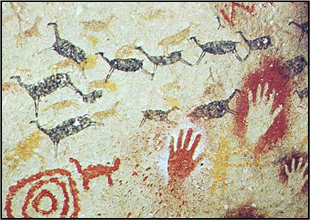
xxxxxSome
paintings are simpler in style, and the many drawings and etchings
include a variety of handprints and hand outlines, a sequence of
symbols which are abstract in form and meaning, and an assortment
of anthropomorphic figures, such as human bodies with animal
heads. Other chambers contain a large number of engraved or black-painted
figures.
xxxxxThe purpose
of these cave paintings is not known. Some observers have
suggested that they were simply a means of decoration, the
products of a leisure activity, or even the graffiti of the
Paleolithic Age. Such ideas are most unlikely. The art work was
done in gloomy recesses and in cramped, difficult conditions,
hardly places in which to pass one’s leisure hours. Because of the
preponderance of animal figures it might well be that the
paintings formed part of some hunting or religious ritual in which
thanks were offered up for the wildlife upon which early man
depended. Another theory is that they were part of an initiation
ceremony. They were clearly produced over a number of years so
this is a possibility.
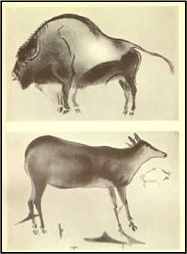 xxxxxBut for whatever purpose they served, these paintings
were the first of this type of Paleolithic art to be discovered.
Since 1879 several hundred sites of cave art have been found,
particularly in France and other parts of Spain, but none save one
has come up to the size and excellence of the mural works found at
Altamira. Thexone site that compares
favourably with Altamira is the Lascaux
grotto in the Dordogne, south-west
France. Discovered in 1940, this has a larger display of art work
from the same period, but after being opened to the public the
paintings deteriorated rapidly and the cave had to be closed in
1963. A facsimile was opened nearby twenty years later. (The
illustrations here show the remarkable talent of these stone-age
artists.)
xxxxxBut for whatever purpose they served, these paintings
were the first of this type of Paleolithic art to be discovered.
Since 1879 several hundred sites of cave art have been found,
particularly in France and other parts of Spain, but none save one
has come up to the size and excellence of the mural works found at
Altamira. Thexone site that compares
favourably with Altamira is the Lascaux
grotto in the Dordogne, south-west
France. Discovered in 1940, this has a larger display of art work
from the same period, but after being opened to the public the
paintings deteriorated rapidly and the cave had to be closed in
1963. A facsimile was opened nearby twenty years later. (The
illustrations here show the remarkable talent of these stone-age
artists.)
xxxxxIncidentally, when, in 1902, it was finally agreed that the
paintings at Altamira were genuine, the French prehistorian Émile Cartailhac (1845-1921),
who had even suggested forgery at one time, had the good grace to
admit his mistake in an article in the journal L’Anthropologie
entitled Mea culpa d’une sceptique.
Unfortunately this was no comfort for Marcelino de Sautuola. He
had died in 1888. ……
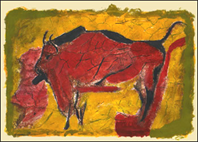 xxxxx…… The
reason why the paintings were in such an excellent state of
preservation when discovered in 1879 (and thus made the experts
sceptical) is put down to the fact that a rock fall some 13,000
years ago sealed up the cave. It was only in recent years -
possibly in the early 19th century - that a tree came down
near the site and displaced some of the rocks in front of the
entrance. To prevent damage to the art work, visiting is strictly
limited, but in 2001 a replica cave and a museum were opened close
by. Altamira (meaning “high view” in Spanish) was declared a world
heritage site by UNESCO in 1985. ……
xxxxx…… The
reason why the paintings were in such an excellent state of
preservation when discovered in 1879 (and thus made the experts
sceptical) is put down to the fact that a rock fall some 13,000
years ago sealed up the cave. It was only in recent years -
possibly in the early 19th century - that a tree came down
near the site and displaced some of the rocks in front of the
entrance. To prevent damage to the art work, visiting is strictly
limited, but in 2001 a replica cave and a museum were opened close
by. Altamira (meaning “high view” in Spanish) was declared a world
heritage site by UNESCO in 1985. ……
xxxxx…… A number of artists have been influenced by the
Altamira cave paintings, including the Spanish cubist painter and
sculptor Pablo Picasso. He visited the cave and afterwards made
his famous remark: “After Altamira all is decadence”. ……
xxxxx…… Santillana del Mar is known as “the town of the three
lies”. It is not a “Saint” (San); it is
not “flat” (llana), and it is not by the
“sea” (Mar)!
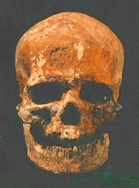 xxxxxInx1868 the French geologist
Louis Lartet
(1840-1899) investigated five skeletons which had been found
by workman in a cave at Cro-Magnon in the Dordogne area of
southern France. Buried alongside stone tools, ivory pendants and
an assortment of shells, these human bones proved to be between
10,000 and 35,000 years old and virtually identical in form to
modern man. Named Cro-Magnon man, this term describes the
first homo sapiens in Europe, the very toolmakers, hunters and
artists who decorated caves like those at Altamira and Lascaux.
xxxxxInx1868 the French geologist
Louis Lartet
(1840-1899) investigated five skeletons which had been found
by workman in a cave at Cro-Magnon in the Dordogne area of
southern France. Buried alongside stone tools, ivory pendants and
an assortment of shells, these human bones proved to be between
10,000 and 35,000 years old and virtually identical in form to
modern man. Named Cro-Magnon man, this term describes the
first homo sapiens in Europe, the very toolmakers, hunters and
artists who decorated caves like those at Altamira and Lascaux.







 xxxxxIt was in 1868
that a local hunter named Modesto Peres stumbled
by chance upon a large cave situated on the hill of Altamira near
Santillana del Mar, close to the north coast of Spain. Herdsmen
and other hunters had often used the cave for shelter, but it was
he who noticed some outlined tracings on the walls near the
entrance and told others of his find. However, it was not until
1875 that the nobleman Don Marcelino de Sautuola (1831-
xxxxxIt was in 1868
that a local hunter named Modesto Peres stumbled
by chance upon a large cave situated on the hill of Altamira near
Santillana del Mar, close to the north coast of Spain. Herdsmen
and other hunters had often used the cave for shelter, but it was
he who noticed some outlined tracings on the walls near the
entrance and told others of his find. However, it was not until
1875 that the nobleman Don Marcelino de Sautuola (1831- xxxxxHaving attended the World Exposition in Paris the
previous year, where he had seen similar images engraved on stone-
xxxxxHaving attended the World Exposition in Paris the
previous year, where he had seen similar images engraved on stone-
 xxxxxBut for whatever purpose they served, these paintings
were the first of this type of Paleolithic art to be discovered.
Since 1879 several hundred sites of cave art have been found,
particularly in France and other parts of Spain, but none save one
has come up to the size and excellence of the mural works found at
Altamira. Thexone site that compares
favourably with Altamira is the Lascaux
grotto in the Dordogne, south-
xxxxxBut for whatever purpose they served, these paintings
were the first of this type of Paleolithic art to be discovered.
Since 1879 several hundred sites of cave art have been found,
particularly in France and other parts of Spain, but none save one
has come up to the size and excellence of the mural works found at
Altamira. Thexone site that compares
favourably with Altamira is the Lascaux
grotto in the Dordogne, south- xxxxx…… The
reason why the paintings were in such an excellent state of
preservation when discovered in 1879 (and thus made the experts
sceptical) is put down to the fact that a rock fall some 13,000
years ago sealed up the cave. It was only in recent years -
xxxxx…… The
reason why the paintings were in such an excellent state of
preservation when discovered in 1879 (and thus made the experts
sceptical) is put down to the fact that a rock fall some 13,000
years ago sealed up the cave. It was only in recent years - xxxxxInx1868 the French geologist
Louis Lartet
(1840-
xxxxxInx1868 the French geologist
Louis Lartet
(1840-


